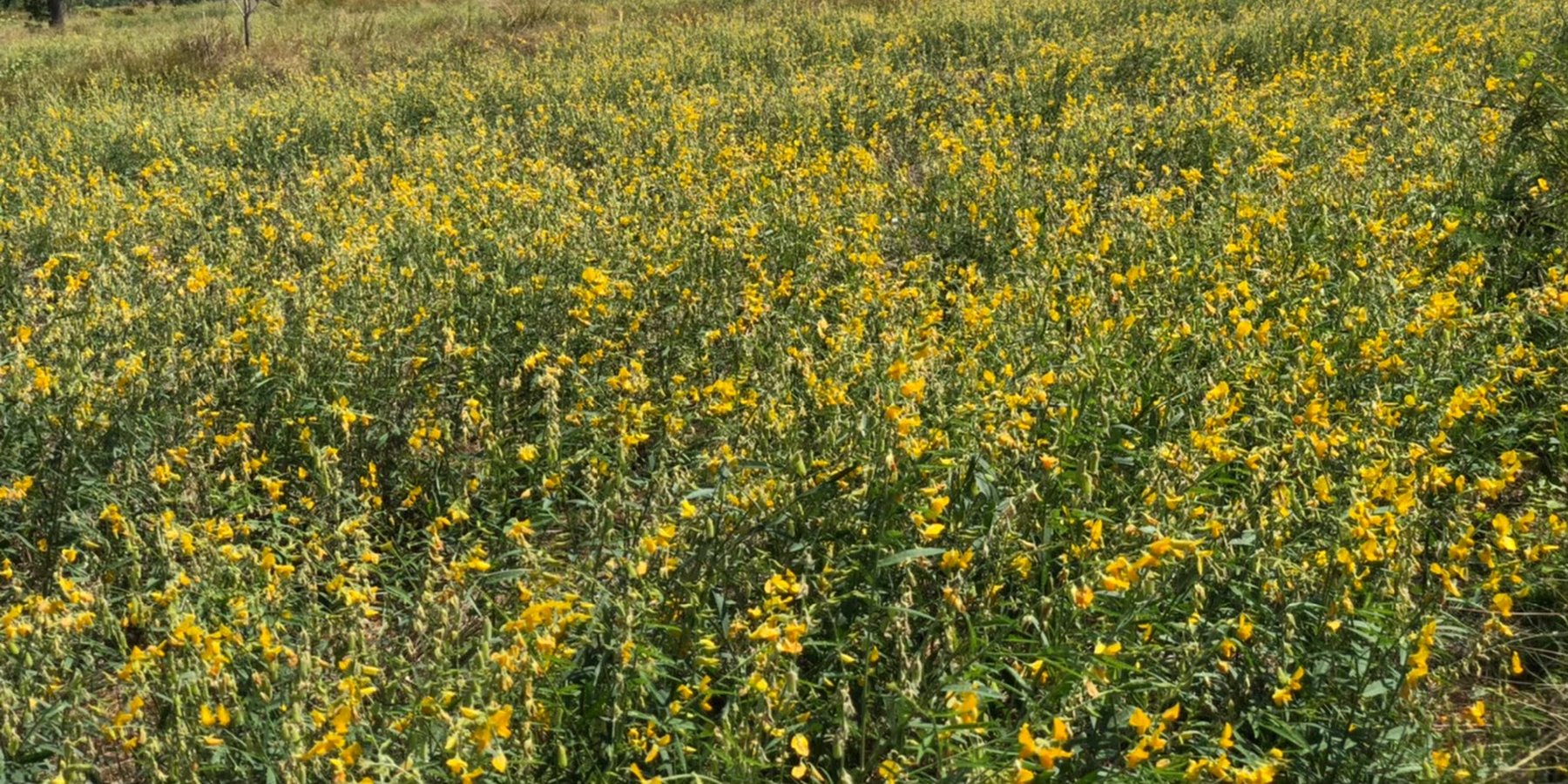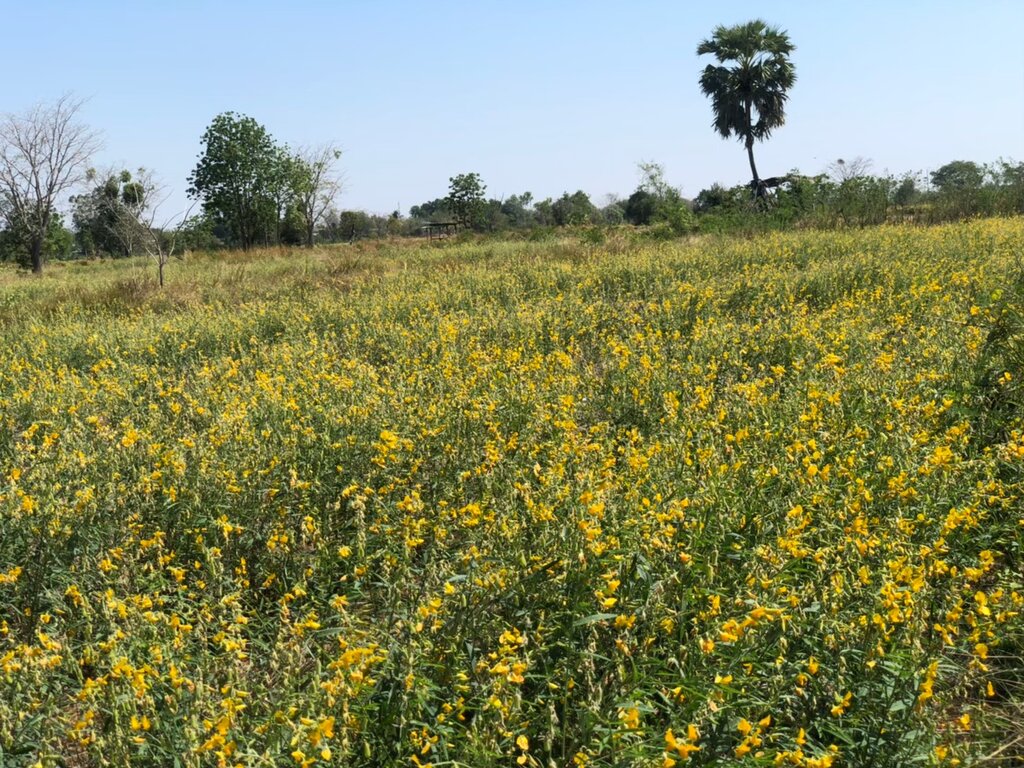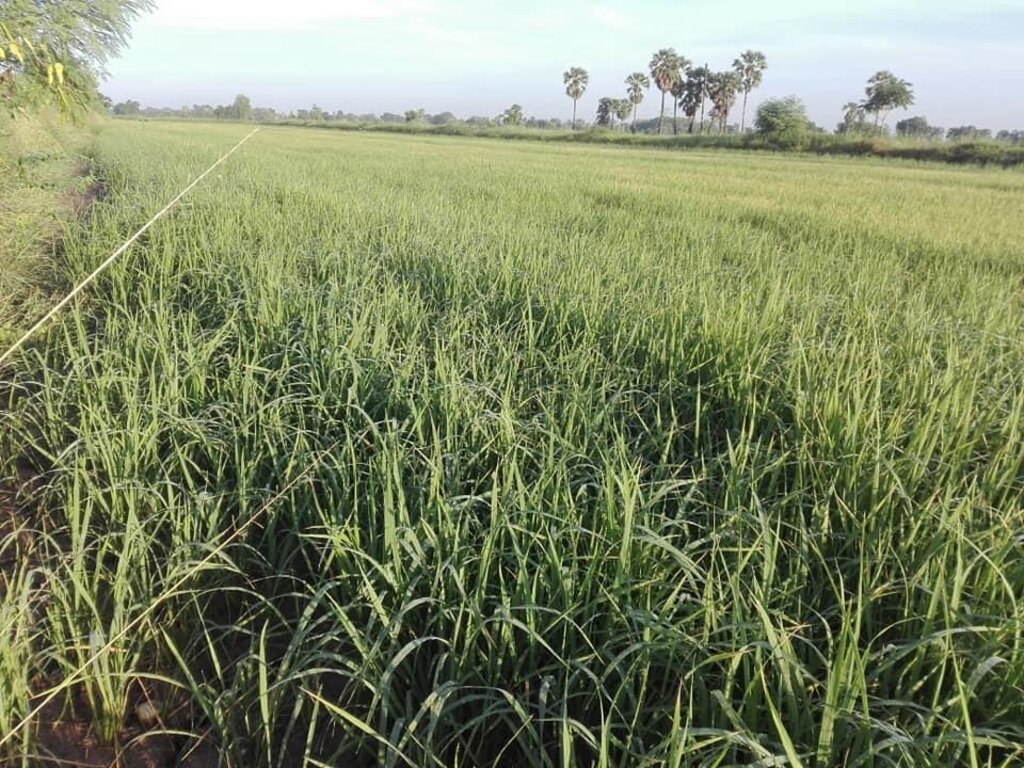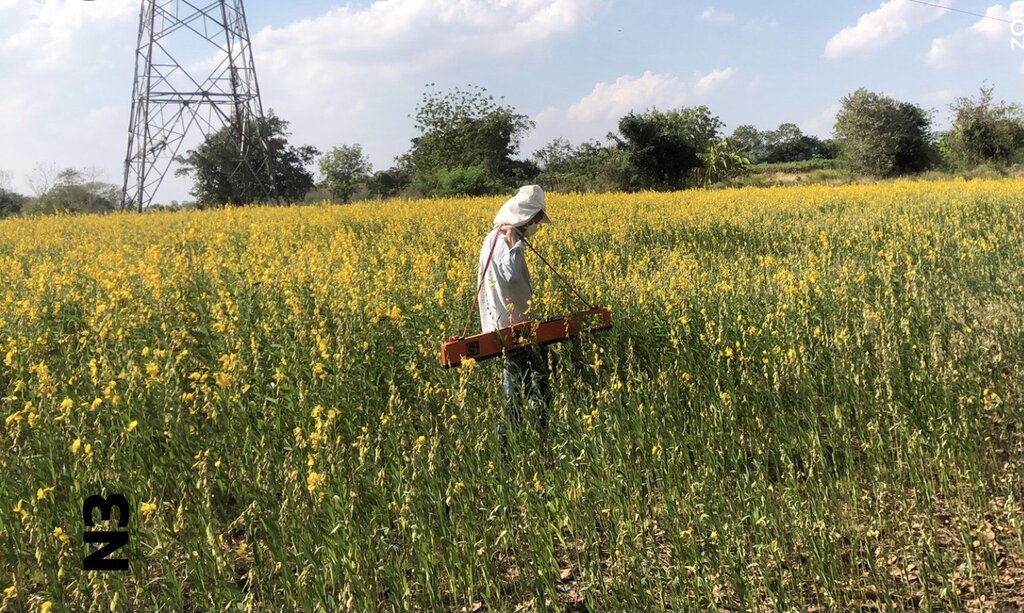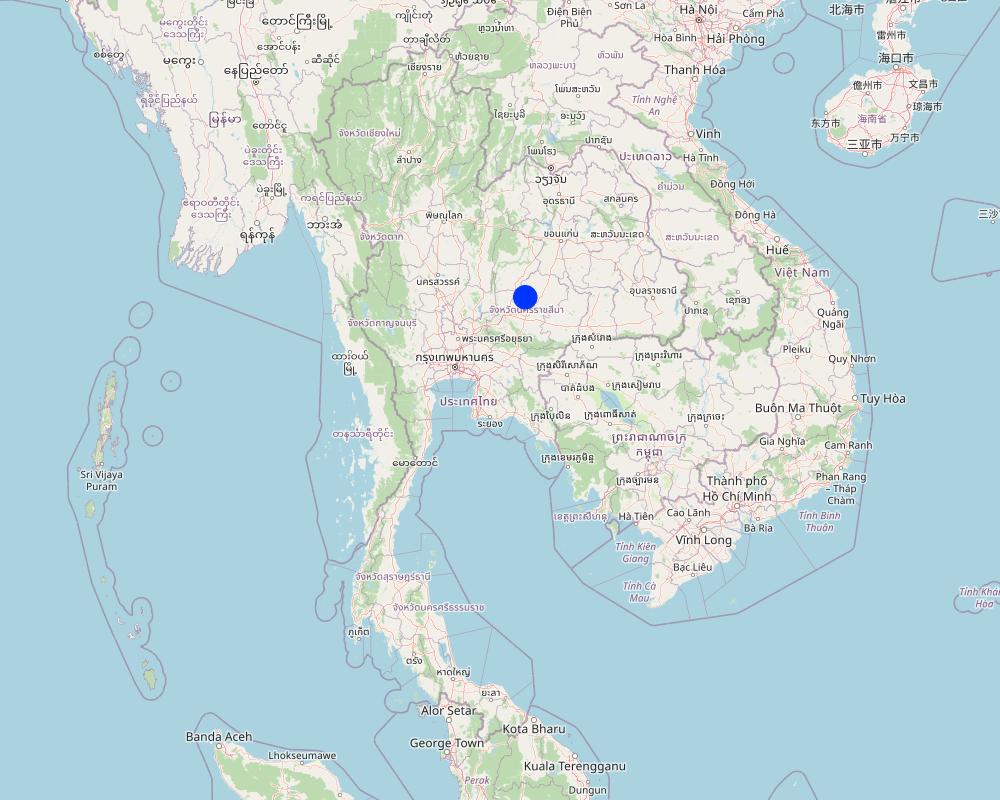SUNN HEMP AS A SOIL AMENDMENT AND FOR MITIGATION OF SALINITY [Thailand]
- Creation:
- Update:
- Compiler: Laksamee Mettpranee
- Editor: –
- Reviewers: William Critchley, Rima Mekdaschi Studer, Joana Eichenberger
technologies_7274 - Thailand
View sections
Expand all Collapse all1. General information
1.2 Contact details of resource persons and institutions involved in the assessment and documentation of the Technology
Key resource person(s)
land user:
Siangsunthia Mana
Thailand
Compiler:
co-compiler:
Raksasarp Pithcanun
Land Development Department
Thailand
co-compiler:
reviewer:
reviewer:
Name of project which facilitated the documentation/ evaluation of the Technology (if relevant)
Decision Support for Mainstreaming and Scaling out Sustainable Land Management (GEF-FAO / DS-SLM)Name of the institution(s) which facilitated the documentation/ evaluation of the Technology (if relevant)
Land Development Department (Land Development Department) - ThailandName of the institution(s) which facilitated the documentation/ evaluation of the Technology (if relevant)
Centre of Excellence for Soil Research in Asia (CESRA)1.3 Conditions regarding the use of data documented through WOCAT
The compiler and key resource person(s) accept the conditions regarding the use of data documented through WOCAT:
Yes
1.4 Declaration on sustainability of the described Technology
Is the Technology described here problematic with regard to land degradation, so that it cannot be declared a sustainable land management technology?
No
1.5 Reference to Questionnaire(s) on SLM Approaches (documented using WOCAT)
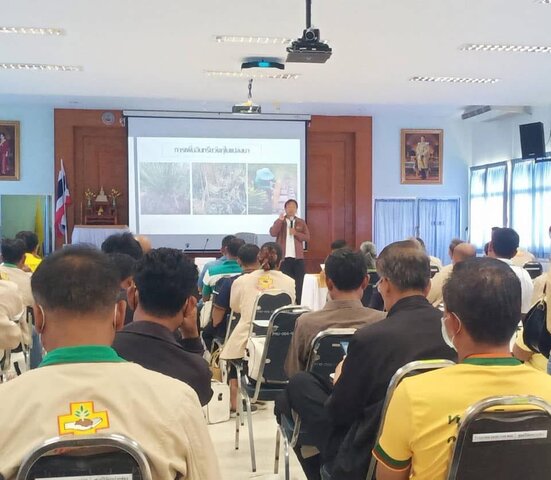
EXTENSION OF SUNN HEMP AS A SOIL AMENDMENT … [Thailand]
An outreach programme aims to educate farmers about the benefits of ploughing rice stubble into the soil and incorporating green manure crops such as sunn hemp - as well as other sustainable practices. Groups of farmers are formed, and they are assisted by various organisations including the Land Development Department …
- Compiler: Laksamee Mettpranee
2. Description of the SLM Technology
2.1 Short description of the Technology
Definition of the Technology:
Sunn hemp (Crotalaria juncea) has been promoted by the Land Development Department as a green manure plant with the objectives of increasing soil organic matter, improving soil fertility and reducing salinity levels.
2.2 Detailed description of the Technology
Description:
The Northeast of Thailand has the largest area dedicated to rice production in the country. However, the average yield per hectare remains low. Here, rice production heavily depends on rainfall, but distribution is inconsistent. Additionally, soil fertility is low, with a rapid decline in soil organic matter (SOM). Another significant threat to productivity in this area is salinity, with 17% of the rice production area affected.
The Land Development Department (LDD) of the Ministry of Agriculture and Cooperatives has promoted the use of soil amendments, such as green manure plants - including sunn hemp (Crotalaria juncea) - to enhance organic matter and restore soil fertility under saline conditions. Green manures are ploughed under, and incorporated into the soil to achieve their effect.
In the Non Thai district of Nakhon Ratchasima province, farmers face water shortages during the dry season, as the area lies outside the irrigation zone. Farmers, along with officers from the Land Development Department, have worked to increase SOM in degraded soils through knowledge transfer. Volunteer soil doctors and local farmers have adopted technologies that combine SOM improvement with soil and water conservation measures.
One notable example is Mr. Mana Siangsuthia: since 1997, he has collaborated with LDD officers, receiving beneficial microorganisms (PD microorganisms), green manure plants, vetiver grass, and water resources for his paddy fields. He has implemented LDD guidelines to develop his 1.12 hectare rice plot. Previously, this land was unproductive due to soil degradation caused by long-term monoculture of industrial crops and excessive use of synthetic fertilizers.
Fermented bio-extracts from banana shoots and chemical fertilizers were applied according to recommended guidelines. In 2004, rice yields averaged 1,125–1,550 kg/ha. Continuous implementation of these practices raised yields to 2,500 kg/ha by 2011. Over 16 years, using sunn hemp as a soil amendment significantly improved soil aggregate stability and reduced salinity. This success led to a shift towards natural agriculture practices in 2013, where chemical fertilizers were no longer used.
Farmers in the area now employ weather observation techniques and efficient water management strategies during dry spells. Green manure plants are sown every two years, complemented by the cultivation of salt-tolerant rice varieties, which also exhibit drought and pest resistance. These practices have resulted in rice yields of 3,125–3,750 kg/ha.
After rice harvesting, rice straw and stubble are ploughed in together with banana shoot PD 2 bio-extract. After approximately 2 weeks of decomposition, sunn hemp is sown at the rate of 31.25 kg/ha. When sunn hemp reaches 120 days, its seeds are collected. Then sunn hemp stems of around 1.2 meters height are ploughed in order to obtain more biomass.
Water conservation remains a focus in the cultivation area. During the rainy season, excess rainwater is stored for use during dry periods. Additionally, farmers employ techniques to wash salt from the soil surface into drainage channels. Water quality is enhanced using fermented bio-extracts, ensuring adequate water for dry-season cultivation.
2.3 Photos of the Technology
2.5 Country/ region/ locations where the Technology has been applied and which are covered by this assessment
Country:
Thailand
Region/ State/ Province:
Nakhonratchasima
Further specification of location:
Moo 5, Ban Kok Phrom, Non Thai sub-district, Non Thai district
Specify the spread of the Technology:
- evenly spread over an area
If the Technology is evenly spread over an area, specify area covered (in km2):
11200.0
Is/are the technology site(s) located in a permanently protected area?
No
Map
×2.6 Date of implementation
Indicate year of implementation:
1999
If precise year is not known, indicate approximate date:
- 10-50 years ago
2.7 Introduction of the Technology
Specify how the Technology was introduced:
- through land users' innovation
- through projects/ external interventions
Comments (type of project, etc.):
The technology arises from land users’ innovation and is supported by external interventions and government agencies that acknowledge the value of technology to the community by providing resources, funding and supporting research and development.
3. Classification of the SLM Technology
3.1 Main purpose(s) of the Technology
- improve production
- reduce, prevent, restore land degradation
- conserve ecosystem
- preserve/ improve biodiversity
- create beneficial economic impact
3.2 Current land use type(s) where the Technology is applied
Land use mixed within the same land unit:
No

Cropland
- Annual cropping
- sunhemp - rice
Number of growing seasons per year:
- 1
Is intercropping practiced?
No
Is crop rotation practiced?
Yes
If yes, specify:
Rice and sunn hemp
3.3 Has land use changed due to the implementation of the Technology?
Has land use changed due to the implementation of the Technology?
- Yes (Please fill out the questions below with regard to the land use before implementation of the Technology)
Land use mixed within the same land unit:
No

Cropland
- Annual cropping
- sunhemp-rice
Is intercropping practiced?
No
Is crop rotation practiced?
No
3.4 Water supply
Water supply for the land on which the Technology is applied:
- mixed rainfed-irrigated
Comments:
Rainfed lowland rice can be supported by small ponds for irrigation.
3.5 SLM group to which the Technology belongs
- improved ground/ vegetation cover
- integrated soil fertility management
3.6 SLM measures comprising the Technology

agronomic measures
- A1: Vegetation/ soil cover
- A2: Organic matter/ soil fertility
3.7 Main types of land degradation addressed by the Technology

chemical soil deterioration
- Cs: salinization/ alkalinization

biological degradation
- Bc: reduction of vegetation cover
- Bs: quality and species composition/ diversity decline
3.8 Prevention, reduction, or restoration of land degradation
Specify the goal of the Technology with regard to land degradation:
- prevent land degradation
- restore/ rehabilitate severely degraded land
4. Technical specifications, implementation activities, inputs, and costs
4.1 Technical drawing of the Technology
Technical specifications (related to technical drawing):
Above shows irrigation ponds associated with rice production. Below is the annual planting calendar where sunn hemp is used.
Author:
Wanaporn polsang
Date:
02/08/2020
Technical specifications (related to technical drawing):
Methods of planting Crotalaria juncea (sunn hemp) to be used as a green manure plant in areas with saline soil are as follows:
1. The period of planting is during February to April whereby planting is conducted in between after harvesting rice yields so that Crotalaria juncea ( Sunn hemp) can thrive and give out high biomass.
2. Plough and ferment rice stubble together with using PD 2 bio-extracts to create bacterial process in the soil accelerating decomposition taking about 2 weeks. Then, sunn hemp is sown at the rate of 31.25 kg/ha in the soil with appropriate moisture throughout the plot in order to bring about regular germination.
3. Plowing up and over to cover sunn hemp stubble at the age of 120 days after collecting seeds of sunn hemp whereby the stem of sunn hemp is at the average of more than 1.2 meters resulting in obtaining more biomass. After that, during the period of preparing the area for planting rice, rice can be sowed in May or when there is enough amount of water.
4. When the seeds are kept to be used in the following season, the seed coat of sunn hemp is used as material incorporated with soil to make compost for soil amendment in growing vegetables.
Author:
Wanaporn polsang
Date:
02/08/2020
4.2 General information regarding the calculation of inputs and costs
Specify how costs and inputs were calculated:
- per Technology area
Indicate size and area unit:
1.12 ha
If using a local area unit, indicate conversion factor to one hectare (e.g. 1 ha = 2.47 acres): 1 ha =:
1 ha=6.25 rai
Specify currency used for cost calculations:
- USD
If relevant, indicate exchange rate from USD to local currency (e.g. 1 USD = 79.9 Brazilian Real): 1 USD =:
34.0
4.5 Maintenance/ recurrent activities
| Activity | Timing/ frequency | |
|---|---|---|
| 1. | Planting is conducted in between after harvesting rice yields so that Crotalaria juncea ( Sunn hemp) can thrive and give out high biomass. | February-April |
| 2. | Plough and ferment rice stubble together with using PD 2 bio-extracts to create bacterial process in the soil accelerating decomposition taking about 2 weeks. Then, sunn hemp is sowed at the rate of 31.25 kg/ha in the soil with appropriate moisture throughout the plot in order to bring about regular germination. | February-April |
| 3. | Ploughing up and over to cover sunn hemp stubble at the age of 120 days after collecting seeds of sunn hemp whereby the stem of sunn hemp is at the average of more than 1.2 meters resulting in obtaining more biomass. After that, during the period of preparing the area for planting rice, rice can be sowed in May or when there is enough amount of water. | May-August |
| 4. | When the seeds are kept to be used in the following season, the seed coat of sunn hemp is used as material incorporated with soil to make compost for soil amendment in growing vegetables. | May-August |
Comments:
Ban Kok Phrom Village, Non Thai sub-district, Non Thai district, Nakhon Ratchasima province
4.6 Costs and inputs needed for maintenance/ recurrent activities (per year)
| Specify input | Unit | Quantity | Costs per Unit | Total costs per input | % of costs borne by land users | |
|---|---|---|---|---|---|---|
| Labour | Plow to prepare plots | Time | 1.0 | 14.71 | 14.71 | 100.0 |
| Labour | Sow rice | Time | 1.0 | 17.65 | 17.65 | 100.0 |
| Labour | Pump water | Time | 2.0 | 58.82 | 117.64 | 100.0 |
| Labour | Harvest yield | Time | 1.0 | 183.82 | 183.82 | 100.0 |
| Plant material | Rice seeds | Kilogram | 8.0 | 0.53 | 4.24 | 100.0 |
| Fertilizers and biocides | Weight | Liter | 40.0 | 0.29 | 11.6 | 100.0 |
| Fertilizers and biocides | Green Manure | Kilogram | 5.0 | 0.68 | 3.4 | 100.0 |
| Other | Oil costs for farm truck | Time | 1.0 | 58.82 | 58.82 | 100.0 |
| Total costs for maintenance of the Technology | 411.88 | |||||
| Total costs for maintenance of the Technology in USD | 12.11 | |||||
If land user bore less than 100% of costs, indicate who covered the remaining costs:
The Land Development Department does not provide financial support but instead supports agricultural production inputs, such as green manure seeds and raw materials for compost production.
Comments:
Calculation of costs and expenses
Expenses are calculated per areas using technology (Unit of size and area: 1.12 ha)
The currency used to calculate expenses with the unit as Baht
Exchange rate (to US. dollars) 1 US. Dollars = 34.0 Baht
Average wage in hiring labor per day is 8.82 USD
4.7 Most important factors affecting the costs
Describe the most determinate factors affecting the costs:
1. Labour costs
2. Fuel costs
5. Natural and human environment
5.1 Climate
Annual rainfall
- < 250 mm
- 251-500 mm
- 501-750 mm
- 751-1,000 mm
- 1,001-1,500 mm
- 1,501-2,000 mm
- 2,001-3,000 mm
- 3,001-4,000 mm
- > 4,000 mm
Agro-climatic zone
- sub-humid
5.2 Topography
Slopes on average:
- flat (0-2%)
- gentle (3-5%)
- moderate (6-10%)
- rolling (11-15%)
- hilly (16-30%)
- steep (31-60%)
- very steep (>60%)
Landforms:
- plateau/plains
- ridges
- mountain slopes
- hill slopes
- footslopes
- valley floors
Altitudinal zone:
- 0-100 m a.s.l.
- 101-500 m a.s.l.
- 501-1,000 m a.s.l.
- 1,001-1,500 m a.s.l.
- 1,501-2,000 m a.s.l.
- 2,001-2,500 m a.s.l.
- 2,501-3,000 m a.s.l.
- 3,001-4,000 m a.s.l.
- > 4,000 m a.s.l.
Indicate if the Technology is specifically applied in:
- not relevant
5.3 Soils
Soil depth on average:
- very shallow (0-20 cm)
- shallow (21-50 cm)
- moderately deep (51-80 cm)
- deep (81-120 cm)
- very deep (> 120 cm)
Soil texture (topsoil):
- coarse/ light (sandy)
Soil texture (> 20 cm below surface):
- medium (loamy, silty)
Topsoil organic matter:
- medium (1-3%)
5.4 Water availability and quality
Ground water table:
on surface
Availability of surface water:
good
Water quality (untreated):
for agricultural use only (irrigation)
Water quality refers to:
surface water
Is water salinity a problem?
Yes
Is flooding of the area occurring?
No
5.5 Biodiversity
Species diversity:
- medium
Habitat diversity:
- medium
5.6 Characteristics of land users applying the Technology
Sedentary or nomadic:
- Sedentary
Market orientation of production system:
- mixed (subsistence/ commercial)
Off-farm income:
- > 50% of all income
Relative level of wealth:
- average
Individuals or groups:
- individual/ household
Gender:
- men
Age of land users:
- elderly
5.7 Average area of land used by land users applying the Technology
- < 0.5 ha
- 0.5-1 ha
- 1-2 ha
- 2-5 ha
- 5-15 ha
- 15-50 ha
- 50-100 ha
- 100-500 ha
- 500-1,000 ha
- 1,000-10,000 ha
- > 10,000 ha
Is this considered small-, medium- or large-scale (referring to local context)?
- small-scale
5.8 Land ownership, land use rights, and water use rights
Land ownership:
- individual, titled
Land use rights:
- individual
Are land use rights based on a traditional legal system?
Yes
5.9 Access to services and infrastructure
health:
- poor
- moderate
- good
education:
- poor
- moderate
- good
technical assistance:
- poor
- moderate
- good
employment (e.g. off-farm):
- poor
- moderate
- good
markets:
- poor
- moderate
- good
energy:
- poor
- moderate
- good
roads and transport:
- poor
- moderate
- good
drinking water and sanitation:
- poor
- moderate
- good
financial services:
- poor
- moderate
- good
6. Impacts and concluding statements
6.1 On-site impacts the Technology has shown
Socio-economic impacts
Production
crop production
Quantity before SLM:
Being areas with saline soils with salt stain on the soil surface, yields per hectare
Quantity after SLM:
Soil properties become better, the quantity of products increases
crop quality
Quantity before SLM:
Yields per hectare are low.
Quantity after SLM:
The plants receive nutrients and the soil quality improves resulting in better product quality.
land management
Quantity before SLM:
Factors and soil amendment materials are used continuously every year.
Quantity after SLM:
Good soil properties make soil management for cultivation become easier.
Comments/ specify:
Using a questionnaire
Water availability and quality
irrigation water availability
Quantity before SLM:
Rainwater is used for conducting agricultural farming.
Quantity after SLM:
Water resources in the paddy field
irrigation water quality
Quantity before SLM:
Affected by salt water
Quantity after SLM:
Water qualities are improved by using fermented bio-extracts.
Comments/ specify:
Salt meter
Income and costs
expenses on agricultural inputs
Quantity before SLM:
A large quantity of factors and soil amendment materials were used
Quantity after SLM:
Materials easily found in the area such as fermented extracts, green manure are used.
Comments/ specify:
Using a quetionnaire
farm income
Quantity before SLM:
Low productivity
Quantity after SLM:
Received higher quantity of rice products
Comments/ specify:
Using a quetionnaire
Socio-cultural impacts
food security/ self-sufficiency
Quantity before SLM:
Yields not enough for consumption in the household
Quantity after SLM:
Having the quantity of rice products for household consumption enough throughout the year accounting for 700 kg./year
Comments/ specify:
Using a quetionnaire
health situation
Quantity before SLM:
--
Quantity after SLM:
Conducting natural farming by avoiding fertilizer and chemical application
Comments/ specify:
Using a questionnaire
community institutions
Quantity before SLM:
Study how to solve proStudy how to solve problems by themselvesblems by themselves
Quantity after SLM:
Building interaction of farmers groups in the area based on consulting and mutual problem solving
SLM/ land degradation knowledge
Quantity before SLM:
There is no knowledge propagation.
Quantity after SLM:
Farmers in the adjacent plot accept the technology and implement methods of soil management in their own areas.
Ecological impacts
Soil
soil moisture
Quantity before SLM:
The soil is arid with flaky salt on the soil surface.
Quantity after SLM:
There has been accumulation of organic matter and mulch keeps moistures and reduces water evaporation in the soil.
Comments/ specify:
Collect samples for laboratory testing.
nutrient cycling/ recharge
Quantity before SLM:
--
Quantity after SLM:
Nutrients increase due to planting different crops such as sunn hemp and plowing up and over rice stubble.
Comments/ specify:
Collect samples for laboratory testing.
salinity
Quantity before SLM:
Moisture in the soil was low. The soil was characterized by having flaky salt appearing on the soil surface.
Quantity after SLM:
Salinity measured from the soil surface decreased. Organic matter and the number of microbes accumulating in the soil increased.
Comments/ specify:
Collect samples for laboratory testing.
soil organic matter/ below ground C
Quantity before SLM:
--
Quantity after SLM:
Organic matter from plowing up and over to cover rice stubble, green manure plants
Comments/ specify:
Collect samples for laboratory testing.
Biodiversity: vegetation, animals
plant diversity
Quantity before SLM:
--
Quantity after SLM:
Plant varieties which can be planted and grow in the area more such as rice, sunn hemp
Comments/ specify:
Observation
6.2 Off-site impacts the Technology has shown
water availability
Quantity before SLM:
Small-scale water resources
Quantity after SLM:
Expansion of digging ponds resulting in more areas of water storage
6.3 Exposure and sensitivity of the Technology to gradual climate change and climate-related extremes/ disasters (as perceived by land users)
Gradual climate change
Gradual climate change
| Season | increase or decrease | How does the Technology cope with it? | |
|---|---|---|---|
| annual temperature | increase | moderately |
Climate-related extremes (disasters)
Climatological disasters
| How does the Technology cope with it? | |
|---|---|
| heatwave | moderately |
| drought | moderately |
6.4 Cost-benefit analysis
How do the benefits compare with the establishment costs (from land users’ perspective)?
Short-term returns:
neutral/ balanced
Long-term returns:
neutral/ balanced
How do the benefits compare with the maintenance/ recurrent costs (from land users' perspective)?
Short-term returns:
neutral/ balanced
Long-term returns:
neutral/ balanced
6.5 Adoption of the Technology
- 11-50%
Of all those who have adopted the Technology, how many did so spontaneously, i.e. without receiving any material incentives/ payments?
- 11-50%
Comments:
The land users are responsible for covering the costs themselves. The Land Development Department provides support by supplying green manure seeds to demonstrate and test whether growing green manure crops can effectively improve saline soil.
6.6 Adaptation
Has the Technology been modified recently to adapt to changing conditions?
No
6.7 Strengths/ advantages/ opportunities of the Technology
| Strengths/ advantages/ opportunities in the land user’s view |
|---|
| Farmers manage soil and water use integrated farming methods, leading to additional income opportunities |
| Farmers in the area are committed to overcoming challenges and limitation related to soil, water, and environmental conditions |
| Strengths/ advantages/ opportunities in the compiler’s or other key resource person’s view |
|---|
| Support for forming farmer groups in the area to exchange knowledge on soil management for increasing crop yields and addressing local farming issues, as well as developin professions for community farmers. This includes promotiong the production of safe |
6.8 Weaknesses/ disadvantages/ risks of the Technology and ways of overcoming them
| Weaknesses/ disadvantages/ risks in the land user’s view | How can they be overcome? |
|---|---|
| Quality problems of Sunn hemp seeds result in low germination rates. | Land Development Department officials inspect the quality of seeds before they are distributed to farmers. |
7. References and links
7.1 Methods/ sources of information
- field visits, field surveys
8
- interviews with land users
1
- interviews with SLM specialists/ experts
5
7.3 Links to relevant online information
Title/ description:
Sustainable soil management practices in Asia
URL:
https://e-library.ldd.go.th/library/Ebook/bib10906.pdf
Links and modules
Expand all Collapse allLinks

EXTENSION OF SUNN HEMP AS A SOIL AMENDMENT … [Thailand]
An outreach programme aims to educate farmers about the benefits of ploughing rice stubble into the soil and incorporating green manure crops such as sunn hemp - as well as other sustainable practices. Groups of farmers are formed, and they are assisted by various organisations including the Land Development Department …
- Compiler: Laksamee Mettpranee
Modules
No modules


